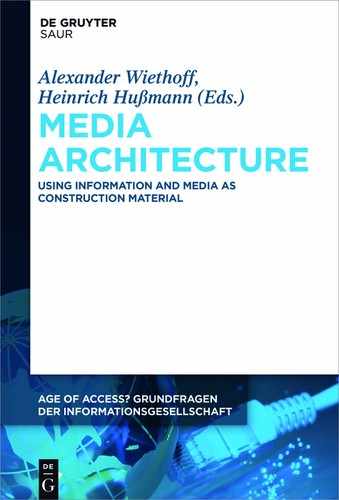Alexander Wiethoff and Heinrich Hußmann
Introduction
Media Architecture is a new term not yet familiar to many people. It refers to the traditional discipline of architecture, as the design of buildings, cities and public locations. However, it extends this discipline by the fusion of digital information with the built environment. The basic idea is to use information as an additional construction material in architecture like glass, wood or concrete. This form of architecture enables citizens to access information through their surroundings instead of using personal devices. Umbrella terms such as “urban computing”, “smart cities” or “urban informatics” also pursue the same basic idea but usually have a wider range of meaning.
Media architecture is about accessibility of information to everybody in a public location. Accessing information via the built environment can empower people to gain more knowledge on their surroundings which in turn can provoke behaviour changes. Examples included in this book exemplify the access of information through media architecture on energy consumption, public transport, pollution levels, availability of resources or sharing goods among communities. We consider it advantageous that media architecture is not only perceived as a “layer-on-top” of existing infrastructure, instead it can be considered as a new, smart construction material that can, if used wisely, enhance the communication and enable a mutual dialogue between city and citizens.
At this point we can clearly identify that the field is maturing not only within the dedicated research communities. Various projects and case studies have been documented in the past and there is a well established conference track addressing this field, however, merely for a research community. By providing this publication we aim to give an overview on the topic, its chances and opportunities, technical feasibility and practical examples in the form of case studies of using media architecture as construction material. Our goal is to reach out to people outside our core research community and to provide interested researchers with potential starting points for entering this domain. Therefore this publication is one of the first broad scientific overviews of media architecture, written by leading practitioners and researchers working in this field.
This book is dissected into three main sections. The first section provides a theoretical discourse on the topic, focusing on the context in which media architecture is applied and its functions in the organism of a city. The second part of the book then reports on practical examples derived from case studies and implementations deployed in the urban environment. The third part addresses the systematic design of media architecture in the public domain and is donated to tool and process models combined with technical opportunities to design the mutual dialogue between buildings and citizens. We close with a personal perspective taken from the perspective of the humanities.
